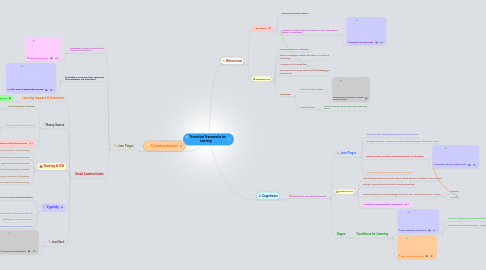
1. Behaviorism
1.1. B.F. Skinner
1.1.1. Environment shapes behavior
1.1.2. Association - links between our behavior & the reinforcement (reward or punishment)
1.1.2.1. Example: the Skinner Box
1.2. Teaching & ICTs
1.2.1. Teaching is behavior modification
1.2.2. Behaviorist approach: breaks a task down into a series of simple steps
1.2.3. Management of class behavior
1.2.4. Reinforcements to change student behavior (rewards and punishments)
1.2.5. SOFTWARE
1.2.5.1. Drill and practice software
1.2.5.1.1. “programmed instruction” rewards a correct answer
1.2.5.2. Tutorial software
1.2.5.2.1. to make learning efficient, especially memorizing basics
2. Cognitivism
2.1. build Internal Conceptual frameworks
2.1.1. Jean Piaget
2.1.1.1. Theoretical Basis: the thought process behind the behavior
2.1.1.2. Changes in Behavior : only as an indicator to what is going on in the learner's head
2.1.1.3. Memory system: an active, organized processor of information
2.1.1.3.1. Example: Atkinson-Shiffrin model
2.1.1.4. Prior Knowledge: plays an important role in learning
2.1.2. Teaching & ICTs
2.1.2.1. Ask interesting questions, Use multi-media to attract attention of students, Present content
2.1.2.2. Highlight important points and relate to existing knowledge
2.1.2.3. Practice exercises for moving knowledge from Short Term Memory to Long Term Memory
2.1.2.3.1. Rehearsal
2.1.2.3.2. Feedback
2.1.2.4. Example: Learning Model of Cognitivism
2.1.3. Gagne
2.1.3.1. Conditions for Learning
2.1.3.1.1. Five Categories of Learning
2.1.3.1.2. Nine Instructional Events
3. Constructivism
3.1. Jean Piaget
3.1.1. knowledge is actively constructed by the mind of the learner
3.1.1.1. Piaget active learner
3.1.2. knowledge is constructed from experience (accommodation and assimilation)
3.1.2.1. Kolb's Cycle of Experiential Learning
3.1.3. Social Constructivism
3.1.3.1. Learning happens & Interactive
3.1.3.1.1. Example:Seymour Papert of MIT Media Lab
3.1.3.2. Theory Source
3.1.3.2.1. social negotiation of meaning
3.1.3.2.2. sharing of multiple perspectives
3.1.3.2.3. changing of internal representations through collaborative learning
3.1.3.3. Teaching & ICTs
3.1.3.3.1. Learning: be situated in realistic settings
3.1.3.3.2. Testing: be integrated with the task and not a separate activity
3.1.3.3.3. Teachers: guide and facilitate (not impose)
3.1.3.3.4. Methods& Materials:be available to suit individual learning styles / potential
3.1.3.3.5. Learning Activities:be collaborative, with a group construction of knowledge
3.1.3.3.6. Community of Practice: create a small organizational culture of shared artifacts, with shared meanings
3.1.3.4. Vygotsky
3.1.3.4.1. Zone of Proximal Development(ZPD)
3.1.3.4.2. the difference between what a learner can do without help and what he or she can do with help
3.1.3.4.3. Scaffolding is a more modern term
3.1.3.4.4. guided learning via focused questions and positive interactions
3.1.3.5. Laurillard
3.1.3.5.1. Conversational framework
